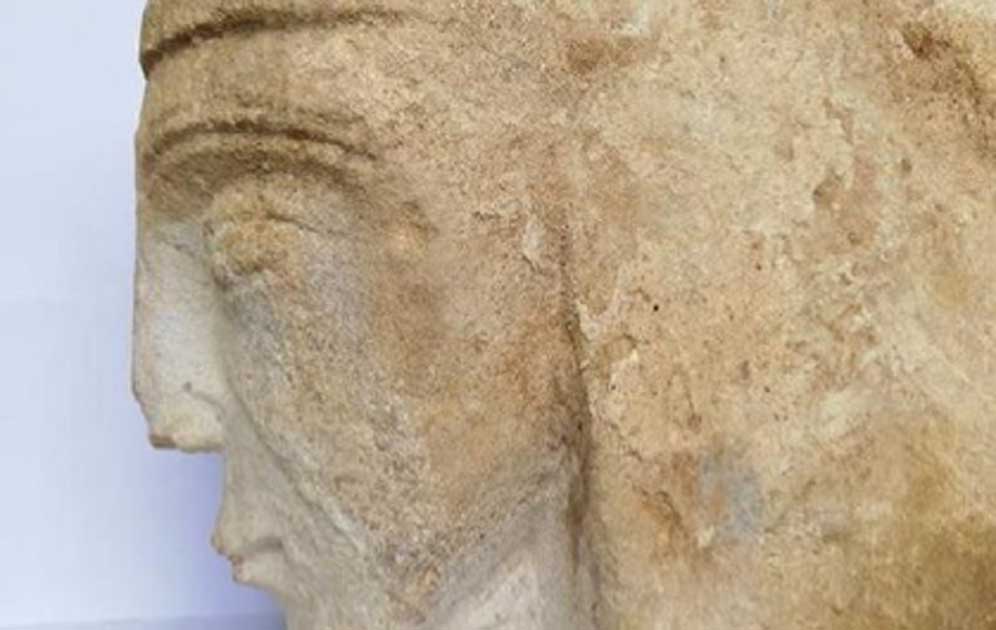Carving Believed to be Rare Depiction of Eleanor of Aquitaine Found in Abbey
A potentially historic discovery has been made in a medieval abbey in England. During a conservation project, the head of one of England’s most powerful queens was discovered, it has been announced.
The carving is believed to be of Eleanor of Aquitaine, one of the most important women in medieval Europe. The find could be very important as there are very few contemporary artistic representation of the queen.
The Carved Stone Head of Eleanor of Aquitaine is Discovered
The carved head was found during a restoration project at Bradwell Abbey in Milton Keynes, Buckinghamshire, in southern England. Bradwell Abbey was established in the 11th century by the Benedictine Order.

Front view of the stone carving of Eleanor of Aquitaine that was discovered. (Milton Keynes Council)
It was dissolved during the English Reformation and fell into ruin. According to the MK Citizen, the abbey “has suffered from aging since the 16th century, with only the chapel remaining in its entirety”.
While working on some of the remains of the 12th-century priory, experts made this remarkable discovery. They found a well-preserved stone carving of a woman’s head. “The carving is thought to be original to the 12 th century abbey” according to Archaeology.org. A preliminary study was undertaken by experts and they came to the astonishing conclusion that the “stone carving may depict the head of Eleanor of Aquitaine” reports the Archaeology.org.
- Henrietta of England and Her Tragic Life of Calamities and Heartbreak
- The Rosslyn Chapel Carvings: Facts, Mysteries, and Conspiracies
- Bloody Mary: Tumultuous Beginnings for a Future Queen of England

Benedictine priory Chapel of Our Lady, Bradwell Abbey. (John Salmon / CC BY-SA 2.0)
The Story of the Queen Eleanor of Aquitaine
Eleanor of Aquitaine (1122-1204), was one of the most extraordinary women in the Middle Ages. She was born to the most powerful noble in France and upon her father’s death controlled more territory in France than the king himself.
She married the French monarch Louis VII in 1152. Eleanor, who was reputedly very beautiful, had enormous influence over the French king. However, they became estranged during a crusade and their marriage was annulled. Later she married the future Henry II of England, a monarch who ruled a realm from southern France to Ireland, which is known as the Angevin Empire.

Eleanor of Aquitaine. (Rezo1515 / CC BY-SA 4.0)
Eleanor had eight children with Henry including four sons who lived to adulthood. Her marriage to the English king, who was 11 years her junior was tempestuous, and many believe that she incited her sons to rebel against their father.
When Eleanor tried to join her rebellious sons in France, she was imprisoned for a decade. When Henry II died, her eldest son Richard I (the Lionheart) became king and Eleanor became his key advisor. After the death of Richard her other son was crowned King John I and she became even more influential.
Eleanor tried to broker a peace treaty between France and England to prevent a war. When this failed she defended Aquitaine against the French with some success, despite being almost 80 years old.
She ensured that the English did not lose all their possessions in France during what amounted to a disastrous reign of King John I. The queen was also a great patron of the arts.
The Mystery of the Carving of Eleanor of Aquitaine
It should not be noted that it has not been proven that the sculpted head represents Eleanor of Aquitaine. There has been no definitive evidence offered that the stonework is that of the woman who was both Queen of France and England. Further research may be needed to verify that the head is that of Eleanor of Aquitaine.
The head was unveiled at the Bradwell Abbey and is now on public display at the Bradwell Abbey Interpretation Centre. It is being exhibited with “another recent find of medieval paintwork” according to the MK Citizen. A stone that was part of the original priory is also on display.
It has also been announced that more funding for the conservation of the historic Abbey is being made available. In total, some $1.75 million (£1.4 million) will be spent on the restoration of the historic site.
The British Minister for Cultural Heritage Jenny Marklew thanked “council colleagues and partners for their efforts in delivering this project” reports MK Citizen. Eventually the carved head will be transferred to the local MK Museum.
Top image: Stone carving believed to be of Queen Eleanor of Aquitaine. Source: Milton Keynes Council.
By Ed Whelan

















